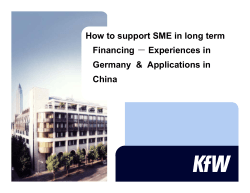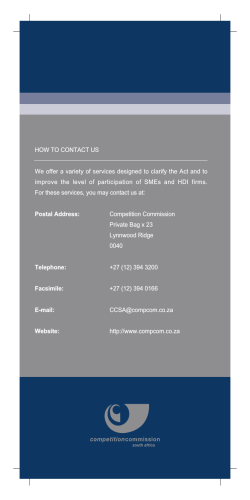
How to participate in FP7 Martin Penny International Cooperation DG Research
How to participate in FP7 Martin Penny International Cooperation DG Research European Commission Presentation outline • FP7 Overview • Why are SMEs and R&D important? • Funding for SMEs in FP7 • How to apply • Overview of funding offered The Framework Programme • The EU programme for research and technological development • Multi-annual programme to integrate research, foster excellence, pool resources, address globalisation etc. • Open to applications from European researchers from all sectors, in collaboration with other European and non-European researchers • Delivers the European Research Area • Established by three key legal texts – the Framework Programme, the Rules for Participation and the Specific Programmes • Separate programmes for nuclear research FP7 2007-2013 Specific Programmes Cooperation – Collaborative research Ideas – Frontier Research People – Human Potential Capacities – Research Capacity + JRC (non-nuclear) JRC (nuclear) Euratom Cooperation – Collaborative research 10 Themes 1. 2. 3. 4. 5. 6. 7. 8. 9. 10. Health Food, agriculture and fisheries and biotechnology Information and communication technologies Nanosciences, nanotechnologies, materials and new production technologies Energy Environment (including climate change) Transport (including aeronautics) Socio-economic sciences & the humanities Space Security Capacities – Research Capacity 1. 2. 3. 4. 5. 6. 7. Research Infrastructures Research for the benefit of SMEs Regions of Knowledge Research Potential Science in Society Coherent Development of Policies Activities of International Cooperation Participation of Moldova • International Cooperation Partner Country (ICPC) • Eligible to receive funding (same rights and obligations) • Consortia must have the minimum required number of MS / AC participants • Expert evaluators – https://cordis.europa.eu/emmfp7/ SMEs and R&D Why should SMEs bother with R&D? Global challenges: environment, energy, ageing, security, food supply, etc. SMEs form 99% of all companies in Europe and are major contributors to growth and employment SMEs have to respond increasingly to a strong competition in the internal market and globally SMEs and R&D Why R&D for SMEs? SMEs should seize the opportunities offered by the transition to a knowledgebased economy & society The ‘global challenges’ are opportunities for all SMEs R&D results should enable SMEs to develop new products, processes and services to enhance their competitiveness EU support allows SMEs to foster and develop transnational R&D cooperation FP7 and SMEs • Creating knowledge for growth (turning knowledge into profit) • Research and technology-driven innovation • FP7 provides financial support for transnational research for and by SMEs wishing to innovate and improve their competitiveness SMEs in FP7 • A grant for research, not a loan. • 75% funding for SMEs in R&D activities • Target of 15% SME participation in (Cooperation Programme) • Over 6000 SMEs have participated so far in FP7 SMEs in FP7 Main initiatives Complementary pillars of SME support in FP7 Budget increase for Dedicated scheme Optimised with special emphasis the SME specific participation of SMEs on SMEs measures Cooperation People Research performing SMEs Research performing SMEs Thematic areas Industry-academia pathways Capacities SMEs outsourcing research Bottom-up approach SMEs in Cooperation • All areas of the programme fully open to SMEs • Specific SME measures (e.g. NMP programme) • Dedicated SME strategy under each Theme • Identification of areas of particular interest to SMEs in each work programme • Simplified financial and administrative procedures SMEs in People All actions are open to SMEs Industry-academia partnerships and pathways (next call Autumn 2010) Staff secondment between academia and industry including SMEs • Temporary hosting of experienced researchers from outside partnership • 10% financial contribution to small equipment related to SME participation • Bottom-up approach: no thematic focus Capacities: Research for the benefit of SMEs Research for SMEs: • Low to medium technology SMEs with little or no research capability • Research intensive SMEs that need to outsource research to complement their core research capability Research for SME associations: • SME associations representing their members and their common technical problems • Bottom-up approach: no thematic focus Who can participate in FP7? • Any undertaking, university or research centre or other legal entity, whether established in a: - Member State (MS), or - Associated country (AC)* , or • International organisations and participants from third countries can participate only if in addition to the minima * Albania, Bosnia & Herzegovina, Croatia, Iceland, Israel, Liechtenstein, FYROM, Montenegro, Norway, Serbia, Switzerland, Turkey, Faroe Islands (from Jan 10) Conditions for participation • Minimum number, as a general rule at least 3 independent participants from 3 different Member States (MS) or Associated countries (AC) • Additional conditions can be established by the work programme or specific programme (number or type of participant, place of establishment) • Specific conditions apply for: – Frontier research actions (Ideas SP), 1 legal entity established in a MS or AC - Marie Curie Actions (People SP) – For specific cooperation actions dedicated to International Cooperation Partner Countries (ICPC) – minimum 4 participants: 2 MS or AC and 2 from ICPC countries Proposal Submission • Submission only through the EPSS – Electronic Proposal Submission Service • Deadlines strict: to the second! • Proposal: – Part A: administrative forms – Part B: main text of proposal • Full information in the Guide for Applicants – specific to each call Evaluation Process • Funding decisions are based on peer review of research proposals • High quality evaluators are at the core of the system • Sign up to be an evaluator! • Quality control – Questionnaire survey of experts – Independent observers – Redress system Eligibility checks • Receipt before deadline – Impossible to be late with EPSS! • Minimum number of independent partners – As set out in work programme and call • Completeness of proposal – Presence of all requested forms • ‘Out of scope’ • Others (e.g. budget limits) For each proposal May be ‘remote’ Proposal X copy 1 Proposal X copy 2 Proposal X copy 3 IER expert 1 IER expert 2 IER expert 3 Note: There may be more than 3 evaluators IER=Individual assessment report CR=Consensus Report Consensus meeting CR 3 experts General principles Forms of grants Reimbursement of eligible costs is the preferred method Flat rates, including scales of unit costs Lump sum amounts, in particular as option for participants from ICPC Principles of co-financing and no profit Upper funding limits Reimbursement according to the type of organisation, of action and/or activity • Research and technological development activities: up to 50% of eligible costs. However, it can be up to 75% for: • Non profit public bodies, secondary and higher education establishments and research organisations, SMEs, and • Security related research (in certain cases) • Demonstration activities: up to 50% • Other activities including management: up to 100% • Frontier research actions: up to 100 % • Coordination and support actions: up to 100% • Training & career development of researchers : up to 100% Upper funding limits Maximum reimbursement rates Research and technological development activities (*) Network of excellence 50% 75% (**) Collaborative project (****) 50% 75% (**) Coordination and support action Demonstration activities 50% Management of the consortium activities Other activities 100% 100% 100% 100% 100% (***) 100% (***) (*) Research and technological development includes scientific coordination. (**) For beneficiaries that are non profit public bodies, secondary and higher education establishments, research organisations and SMEs (***)The reimbursement of indirect eligible costs, in the case of coordination and support actions, may reach a maximum 7% of the direct eligible costs, excluding the direct eligible costs for subcontracting and the costs of reimbursement of resources made available by third parties which are not used on the premises of the beneficiary. (****) Including research for the benefit of specific groups (in particular SMEs). Eligible Costs – Eligible • actual • during duration of project • in accordance with its usual accounting and management principles • recorded in the accounts of beneficiary • used for the sole purpose of achieving the objectives of the project – Non-eligible (identifiable indirect taxes including VAT…) Direct Costs • No cost models (NEW) • All beneficiaries report all their real direct costs Indirect Costs • For all: – either actual overhead or simplified method* – flat rate of 20% of direct costs minus subcontracting and 3rd parties not used on the premises of the beneficiary. • For Non-profit Public Bodies, Secondary and Higher Education establishments, Research Organisations and SMEs unable to identify real indirect costs, may apply for a flat rate of 60% for funding schemes with RTD. • For CSA limit of 7% of direct costs Indirect Costs *simplified method • A participant may use a simplified method to calculate its indirect costs at the level of the legal entity • if this is in accordance with its usual management and accounting principles • If no analytical accounting system • Based on actual costs of the last closed accounting year Why this new approach? to introduce a way to facilitate the transition from the Additional Cost model (abolished) towards the declaration of actual indirect costs Real Indirect Costs Normal Do I have an analytical accounting system allowing to determine with certitude the indirect cost related to research activities ? Simplified Flat Rate 20% YES IF THE ANSWER IS NO, THEN: Do I have an accounting system allowing to identify all my indirect costs and a reliable cost driver to allocate them? YES NO * Only applicable to Non-profit public bodies, Secondary and higher education establishments, Research organisations and SMEs 60% * Example Collaborative project submitted by an SME partner in a consortium, using the 60% flat rate for indirect costs Project Direct Costs 100,000 RTD Costs 50,000 Demonstration 10,000 Management Indirect Costs (60%) 60,000 30,000 6,000 Example Total Project Costs (Direct + Indirect costs) RTD 160,000 Demonstration 80,000 Management 16,000 => Reimbursement i.e. EC contribution RTD 160,000 * 75% = 120,000 Demonstration 80,000 * 50% = 40,000 Management 16,000 * 100% = 16,000 Total EC Contribution =176,000 Payment modalities – One pre-financing (upon entry into force) for the whole duration – Interim payments based on financial statements (EC contribution= amounts justified & accepted * funding rate) – Retention (10%) – Final payment Example Project duration 3 years, EC funding 3 Mio€ • Pre-financing (average EU funding 1M/year, usually 160%) = 1.6 Mio€ • 1st Interim payment 1Mio€ accepted, payment 1Mio€ • 2nd Interim payment 1Mio€ accepted, payment 0,1Mio€ (retention 10%!) • Final payment 0,3Mio€ (retention 10%) Guarantee Fund • No collective financial responsibility • Instead: establishment of a financial guarantee fund to cover risks • 5% of EC contribution • However, there is still a responsibility to carry out the technical aspects of the project Payment modalities EXAMPLE: Project duration 3 years, EC funding 3 Mio€ • Pre-financing = 1.6 Mio€ of which 0,15Mio€ to the Fund • 1st Interim payment 1Mio€ accepted, payment 1Mio€ • 2nd Interim payment 1Mio€ accepted, payment 0,1Mio€ (retention 10%!) • Final payment 0,3Mio€ (retention 10%)+0,15 Mio€ of the Fund Documents and Contacts • Rules for Participation • Work Programme • Rules for Submission and Evaluation of Proposals • Guides for Applicants • NCPs – Network of NCPs in Moldova Further Information • EU research: http://ec.europa.eu/research/ • 7th Framework Programme: http://ec.europa.eu/research/fp7/ • Information on research activities and projects: http://cordis.europa.eu/ • research*eu magazine: http://ec.europa.eu/research/research-eu/ • Questions? http://ec.europa.eu/research/index.cfm?pg =enquiries
© Copyright 2026





















